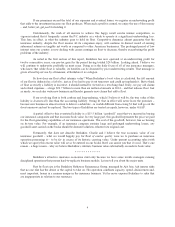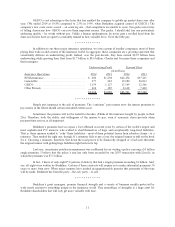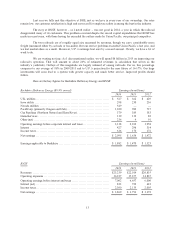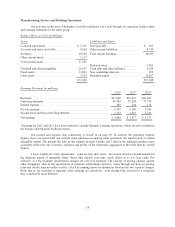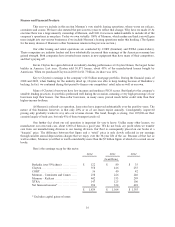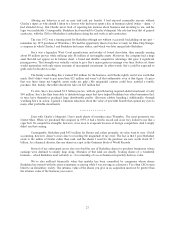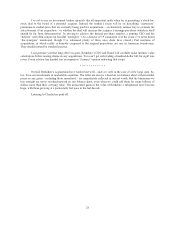Berkshire Hathaway 2014 Annual Report Download - page 21
Download and view the complete annual report
Please find page 21 of the 2014 Berkshire Hathaway annual report below. You can navigate through the pages in the report by either clicking on the pages listed below, or by using the keyword search tool below to find specific information within the annual report.If the investor, instead, fears price volatility, erroneously viewing it as a measure of risk, he may,
ironically, end up doing some very risky things. Recall, if you will, the pundits who six years ago bemoaned falling
stock prices and advised investing in “safe” Treasury bills or bank certificates of deposit. People who heeded this
sermon are now earning a pittance on sums they had previously expected would finance a pleasant retirement. (The
S&P 500 was then below 700; now it is about 2,100.) If not for their fear of meaningless price volatility, these
investors could have assured themselves of a good income for life by simply buying a very low-cost index fund
whose dividends would trend upward over the years and whose principal would grow as well (with many ups and
downs, to be sure).
Investors, of course, can, by their own behavior, make stock ownership highly risky. And many do. Active
trading, attempts to “time” market movements, inadequate diversification, the payment of high and unnecessary fees
to managers and advisors, and the use of borrowed money can destroy the decent returns that a life-long owner of
equities would otherwise enjoy. Indeed, borrowed money has no place in the investor’s tool kit: Anything can
happen anytime in markets. And no advisor, economist, or TV commentator – and definitely not Charlie nor I – can
tell you when chaos will occur. Market forecasters will fill your ear but will never fill your wallet.
The commission of the investment sins listed above is not limited to “the little guy.” Huge institutional
investors, viewed as a group, have long underperformed the unsophisticated index-fund investor who simply sits
tight for decades. A major reason has been fees: Many institutions pay substantial sums to consultants who, in turn,
recommend high-fee managers. And that is a fool’s game.
There are a few investment managers, of course, who are very good – though in the short run, it’s difficult
to determine whether a great record is due to luck or talent. Most advisors, however, are far better at generating high
fees than they are at generating high returns. In truth, their core competence is salesmanship. Rather than listen to
their siren songs, investors – large and small – should instead read Jack Bogle’s The Little Book of Common Sense
Investing.
Decades ago, Ben Graham pinpointed the blame for investment failure, using a quote from Shakespeare:
“The fault, dear Brutus, is not in our stars, but in ourselves.”
The Annual Meeting
The annual meeting will be held on Saturday, May 2nd at the CenturyLink Center. Last year’s attendance
of 39,000 set a record, and we expect a further increase this year as we celebrate our Golden Anniversary. Be there
when the doors open at 7 a.m.
Berkshire’s talented Carrie Sova will again be in charge. Carrie joined us six years ago at the age of 24 as
a secretary. Then, four years ago, I asked her to take charge of the meeting – a huge undertaking, requiring a
multitude of skills – and she jumped at the chance. Carrie is unflappable, ingenious and expert at bringing out the
best in the hundreds who work with her. She is aided by our entire home office crew who enjoy pitching in to make
the weekend fun and informative for our owners.
And, yes, we also try to sell our visiting shareholders our products while they’re here. In fact, this year
we will substantially increase the hours available for purchases, opening for business at the CenturyLink on Friday,
May 1st, from noon to 5 p.m. as well as the usual 7 a.m. to 4 p.m. on meeting day. So bring a smile to Charlie’s face
and do some serious shopping.
Get up early on Saturday morning. At 6:20 a.m., Norman and Jake, two Texas longhorns each weighing
about a ton, will proceed down 10th Street to the CenturyLink. Aboard them will be a couple of our Justin Boot
executives, who do double duty as cowboys. Following the steers will be four horses pulling a Wells Fargo
stagecoach. Berkshire already markets planes, trains and automobiles. Adding steers and stagecoaches to our
portfolio should seal our reputation as America’s all-purpose transportation company.
19


